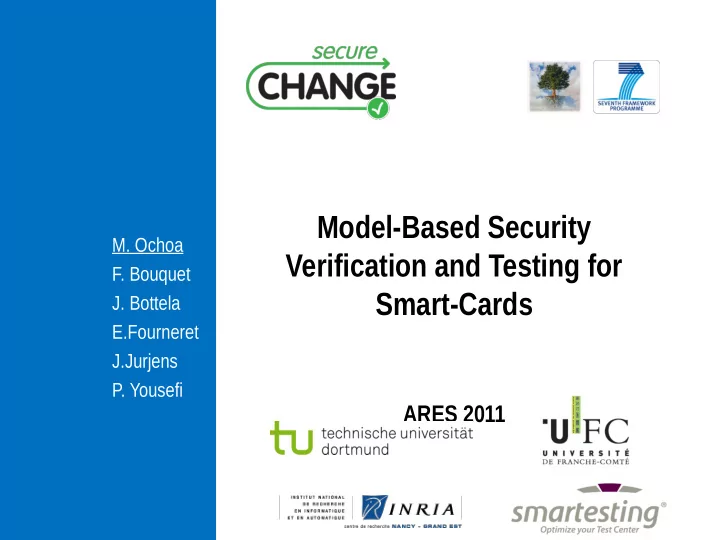

Model-Based Security M. Ochoa Verification and Testing for F. Bouquet Smart-Cards J. Bottela E.Fourneret J.Jurjens P. Yousefi ARES 2011
OUTLINE • Introduction • Background • UMLsec • Model-based Testing • Security in smart-card life-cycles • Correct security testing • Validation E.Fourneret et al. ‘Model-Based Security Verification and Testing for Smart-cards’ 2
Research question? Security by design MBT Can we unify these two approaches? (to some extent) E.Fourneret et al. ‘Model-Based Security Verification and Testing for Smart-cards’ 3
Background: UMLsec UMLsec is a lightweight extension of UML by means of stereotypes and tagged values. • Formally well-founded (based on a formalization of a fragment of UML). • Supports a collection of different security verification techniques across UML system views. • Tool supported . E.Fourneret et al. ‘Model-Based Security Verification and Testing for Smart-cards’ 4
Background: UMLsec Satisfies property P? UML UML system system Model Model Counterexample UMLsec extends Class, Sequence, Activity, Statechart and Deployment diagrams and allows to verify Dolev-Yao cryptography, Non-interference and RBAC among others. There is tool support for most of the UMLsec stereotypes. E.Fourneret et al. ‘Model-Based Security Verification and Testing for Smart-cards’ 5
Background: MBT with Schemas Generated test conform UML UML to model prediction? Model of Model of + Schemas Expected Expected behavior behavior !!! • Automated test generation from security properties to testing needs using schemas • Ensure security property coverage • Traceability between generated tests and security property E.Fourneret et al. ‘Model-Based Security Verification and Testing for Smart-cards’ 6
Background: MBT with Schemas Schema Language: Allows a straightforward, imperative-programming- like definition of Test Schemas, from which automatic test sequences can be generated. For example: E.Fourneret et al. ‘Model-Based Security Verification and Testing for Smart-cards’ 7
Security in Smart-card Life-cycle A smart-card has typically a well-defined life-cycle, that ranges from pre-deployment to active and eventually to a locked-status or a terminated status where is not possible to use the card any more. E.Fourneret et al. ‘Model-Based Security Verification and Testing for Smart-cards’ 8
Security in Smart-card Life-cycle Example: Global Platform Specification v 2.1.1 on the Card Life Cycle Scope E.Fourneret et al. ‘Model-Based Security Verification and Testing for Smart-cards’ 9
Security in Smart-card Life-cycle Natural security requirements on the life-cycle to prevent D.O.S attacks: E.Fourneret et al. ‘Model-Based Security Verification and Testing for Smart-cards’ 10
Correct security testing Main ideas: • Is the expected behaviour, as described by the models in MBT already trivially violating the security properties to be tested? • Can we improve the quality of the MBT by using the UMLsec philosophy? • Can we also automatically generate schemas from this analysis? E.Fourneret et al. ‘Model-Based Security Verification and Testing for Smart-cards’ 11
Correct security testing UMLsec new stereotypes for Security Properties 1 and 2 on statecharts: <<locked-status>> together with tag {status} specifies a status (node) in the statechart that should not have outgoing transitions to other nodes. <<authorized>> together with tags {status} and {permission} checks that all transitions to a given node contain a given permission check in their guard. E.Fourneret et al. ‘Model-Based Security Verification and Testing for Smart-cards’ 12
Correct security testing From the testing perspective, we can express the security properties as hoare triples {P} S {Q} where P and Q are FOL formulas quantifying over system variables and S is a set of system commands. For example: Locked-status: Authorized: E.Fourneret et al. ‘Model-Based Security Verification and Testing for Smart-cards’ 13
Validation Automatically verified some violating models of the GP v 2.1.1 card life- cycle E.Fourneret et al. ‘Model-Based Security Verification and Testing for Smart-cards’ 14
Validation Generated schema: Using the schema we have generated13 tests. E.Fourneret et al. ‘Model-Based Security Verification and Testing for Smart-cards’ 15
CONCLUSION AND FUTURE WORK - Take into account the evolution aspect i.e - Specification can evolve thus the model and/or - The security property can evolve - Schema language extensions - Methods and tools’ evaluation on other systems and for other security properties. - Integration of tool support E.Fourneret et al. ‘Model-Based Security Verification and Testing for Smart-cards’ 16
Questions? 17 E.Fourneret et al. ‘Model-Based Security Verification and Testing for Smart-cards’
Recommend
More recommend